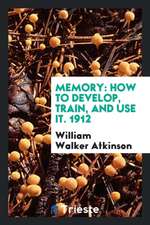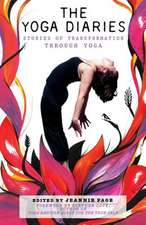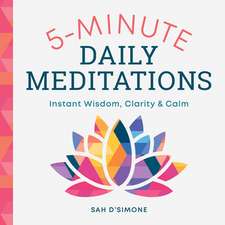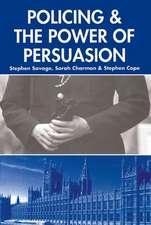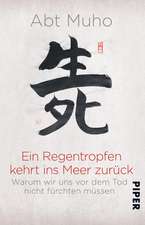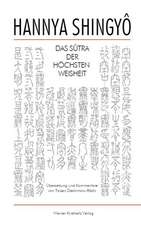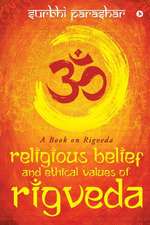The Wisdom of Yoga: A Seeker's Guide to Extraordinary Living
Autor Stephen Copeen Limba Engleză Paperback – 30 apr 2007
While many Westerners still think of yoga as an invigorating series of postures and breathing exercises, these physical practices are only part of a vast and ancient spiritual science. For more than three millennia, yoga sages systematically explored the essential questions of our human existence: What are the root causes of suffering, and how can we achieve freedom and happiness? What would it be like to function at the maximum potential of our minds, bodies, and spirits? What is an optimal human life?
Nowhere have their discoveries been more brilliantly distilled than in a short–but famously difficult–treatise called the Yogasutra. This revered text lays out the entire path of inner development in remarkable detail–ranging from practices that build character and mental power to the highest reaches of spiritual realization.
Now Stephen Cope unlocks the teachings of the Yogasutra by showing them at work in the lives of a group of friends and fellow yoga students who are confronting the full modern catastrophe of careers, relationships, and dysfunctional family dynamics. Interweaving their daily dilemmas with insights from modern psychology, neuroscience, religion, and philosophy, he shows the astonishing relevance and practicality of this timeless psychology of awakening.
Leavened with wit and passion, The Wisdom of Yoga is a superb companion and guide for anyone seeking enhanced creativity, better relationships, and a more ethical and graceful way of living in the world.
From the Hardcover edition.
Preț: 90.39 lei
Preț vechi: 107.87 lei
-16% Nou
Puncte Express: 136
Preț estimativ în valută:
17.30€ • 17.83$ • 14.61£
17.30€ • 17.83$ • 14.61£
Carte disponibilă
Livrare economică 10-17 februarie
Livrare express 24-30 ianuarie pentru 42.42 lei
Preluare comenzi: 021 569.72.76
Specificații
ISBN-13: 9780553380545
ISBN-10: 0553380540
Pagini: 316
Dimensiuni: 168 x 234 x 20 mm
Greutate: 0.36 kg
Editura: Bantam Books
ISBN-10: 0553380540
Pagini: 316
Dimensiuni: 168 x 234 x 20 mm
Greutate: 0.36 kg
Editura: Bantam Books
Notă biografică
Stephen Cope is a psychotherapist, senior Kripalu yoga teacher, and author of Yoga and the Quest for the True Self. He is currently Senior Scholar in Residence at the Kripalu Center for Yoga and Health in Lenox, Massachusetts.
From the Hardcover edition.
From the Hardcover edition.
Extras
Chapter 1
THE SECRET STRENGTH
OF DISILLUSIONMENT
SAMVEGA: TURNING AWAY FROM THE BONE
During the summer of his “breakdown,” all Jake knew was that he couldn’t go backward, and apparently he wouldn’t go forward. The experience of direct involvement with the present moment was just the place in which he had previously been unable to dwell. He was determined now to stay put. He knew that, paradoxically, some great success was buried within his failure. He sensed that he had had some kind of awakening. But what was it?
Yogis call this state samvega–a complex state involving a kind of disillusionment with mundane life, and a wholehearted longing for a deeper investigation into the inner workings of the mind and the self.1 Samvega, as described by the contemporary Buddhist monk Thanissaro Bhikkhu, involves “at least three clusters of feelings at once”:
the oppressive sense of shock, dismay, and alienation that come with realizing the futility and meaninglessness of life as it’s normally lived; a chastening sense of our own complacency and foolishness in having let ourselves live so blindly; and an anxious sense of urgency in trying to find a way out of the meaningless cycle.2
Samvega is a developmental state not mentioned in Western psychological texts. It brings with it a realization that objects of grasping (money, fine things, titles, fame, even people–when seen as objects) cannot supply any true satisfaction. It involves a radical realization that all objects are intrinsically empty of the capacity to feed us in the way we really want–or need–to be fed.
A classic Buddhist teaching story describes this realization:
A dog stumbles across a bone that has been exposed to the elements for many months, and is therefore bleached of any residual flesh or marrow. The dog gnaws on it for some time before he finally determines that he is “not finding” any satisfaction in the bone, and he thus turns away from it in disgust. It is not that the bone is intrinsically disgusting; it is rather the case that the dog’s raging desire for meat just will not be satisfied by the bone . . . when he wakes up to the truth that the bone is empty of anything that will offer him satisfaction, he becomes disenchanted, and spits it out in disgust.3
Of course, the symptoms of samvega arise only after extensive experimentation with “the bone.” Tibetan teacher Chögyam Trungpa Rinpoche says it elegantly: “The shoe of ego is only worn out by walking on it.”4 For many of us, objects of longing gradually reveal themselves to offer no real happiness. No matter how hard we gnaw on them, we find no meat on the bone. Samvega then arises with a linked complex of symptoms, many of which Jake was now experiencing. These can include:
• A puzzling failure of previous sources of satisfaction
• A heightened concern with authenticity
• A deepening pull toward an intuited interior world
• A sense of urgency about realizing deeply hidden gifts and talents
• A global and diffuse sense of internal disorganization–equal parts psychological and spiritual
• A deeply felt internal imperative to stop business as usual–or, as Jake said, to “get quiet”
• A call to explore a path that might give transcendent meaning to the enigmas of life
One of the harbingers of the developmental imperative of samvega is that we–like Jake–begin to hear ourselves muttering about our Old Life and our New Life. Out of the blue, we begin to feel like captives in our lives–lives which may have fit comfortably for years. Our well-known world begins to feel stale and dead. Gradually we start hankering to leave for the New World. We begin to feel imbued with the spirit of our Seeker ancestors. We want nothing more than to leave the Old Country. This internal movement presages a profound reorganization of the psyche, a redirection of the energy of longing, and a completely new relationship with the world of people, places, and things.
Even though this developmental stage is as common in human life as adolescence, one will search Western psychology books in vain for a clear description of its causes and trajectory. We ordinarily attempt to fit the complexities of samvega into our old, usually pathological, categories. We trivialize it as “midlife crisis,” or we wonder if it is not really just neurotic depression, or regression–as Susan Goldstein did when encountering Jake’s version of samvega.
But contrary to the typical Western view, the kind of “breakdown” in which Jake found himself is not a regression into the past. It is not a pathological state. It is not a move backward at all. It is, rather, a step toward the possibility of a vastly expanded way of living in the world.
In yogic texts, the word samvega is often translated as “vehemence,” because it brings with it an unshakeable resolve to develop into a fully alive human being. Patanjali introduces the term samvega in the first chapter of the Yoga-S¯utra–using the word to indicate a “wholehearted” (or “vehement”) determination to find a way out of suffering.
For those who seek liberation wholeheartedly, realization is near. How near depends on whether the practice is mild, moderate, or intense. (1.21—22)
Yogis found that even though this state of “vehemence” carries with it a tremendous amount of feeling and power, it does not disturb the mind–rather it calms the mind. (In the summer of his breakthrough, everyone noticed that Jake was not disturbed. He was calm and profoundly “resolved.”) Samvega is a kind of passion that does not create suffering–but, rather, generates the happiness that comes with the sure knowledge of freedom. Because the state of samvega is so full of possibilities, it is often referred to as a state of “emergence.” Through the practice of yoga, says Patanjali, we can emerge from the traps of ordinary suffering. How quickly this emergence takes place depends on the intensity and persistence of our practice.
NIRODHA: STOP THE WORLD
When samvega emerges, it brings with it an altogether new hunger: the hunger for internal quiet. We seek this quiet not just because we’re exhausted by living at right angles to life–as Jake certainly was–but also so that we can see more clearly. It becomes obvious that in order to know our true nature, we will have to stop the world. Stop the world! The Native American shaman Don Juan gives precisely this advice to his student Carlos Castaneda. “In order to become a man of knowledge, a warrior-traveler, you will first have to learn to stop the world.”5
What does this mean? In order to see clearly, to examine how things work, we will have to stop our lives, slow things down, look carefully–like the person who has suddenly discovered she has created the mother of all knots in the shoelace of her boot. We must stop. Slow down. Look. Examine. How did this happen? How does this work? How can I reverse this? We will have to deconstruct the very way we perceive and rebuild it again from the ground up.
Stop the world. The impulse toward stillness is the central movement of the contemplative life. Monastics through the ages have described it: One intuits some precious new interior self. One sneaks off into the woods like an animal, builds a nest for the birth. Guards it ferociously. And waits in silence.
Says Thomas Merton, one of the great Catholic contemplatives of the twentieth century:
The true contemplative is not one who prepares his mind for a particular message that he wants or expects to hear, but is one who remains empty because he knows that he can never expect to anticipate the words that will transform his darkness into light. He does not even anticipate a special kind of transformation. He does not demand light instead of darkness. He waits on the Word of God in silence, and, when he is answered it is not so much by a word that bursts into his silence. It is by his silence itself, suddenly, inexplicably revealing itself to him as a word of great power, full of the voice of God.6
Jake had an urgent need to stop the world. And he discovered, as all strivers do, that when the mind is still, our true nature begins to reveal itself. Out of stillness, like the early morning mist on the lake, emerges a thinking that is not thinking–a wisdom beyond thought. Out of stillness emerges, effortlessly, a subtle world of experience for which we had only longed until now. It is real. It rolls itself out in waves as we get still, quiet, concentrated, and settled.
The path of classical yoga is organized around the relationship between inner stillness and wisdom. The first two sutras in Patanjali’s
Yogasutra are:
Now, the teachings of yoga.
Yoga is to still the patterning of consciousness. (1.1—2)
The Sanskrit word nirodha, which Patanjali uses in the second sutra, means “stilling, cessation, or restriction.” This stilling is both the path and the goal of yoga. Its appearance at the beginning of the treatise signals its centrality in Patanjali’s technique.
“Yoga is to still the patterning of consciousness.” Yoga is to still the thought waves of the mind. Yoga is to bring a natural quiet to the mind and body–so that we can, for the first time, see clearly. And in this stillness–miraculously, outrageously–the knots undo themselves.
Inner realities emerge.
As both Merton and Don Juan understood, inner stillness opens a doorway in the mind. A little trapdoor we have rarely noticed. A secret escape hatch for the mind that is not even in the Western psychological user’s manual. Merton’s prayer suggests that in order to be found, we must first acknowledge the radical degree to which we’re lost. Then, as the poet David Wagoner suggests, we must pay very close attention:
Stand still. The trees ahead and the bushes beside you
Are not lost. Wherever you are is called Here,
And you must treat it as a powerful stranger,
Must ask permission to know it and be known.
The forest breathes. Listen. It answers,
I have made this place around you.
If you leave it you may come back again, saying Here.
No two trees are the same to Raven.
No two branches are the same to Wren.
If what a tree or a bush does is lost on you,
You are surely lost. Stand still. The forest knows
Where you are. You must let it find you.7
This teaching captures the essence of the yogic view: what we are searching for is also searching for us. The way is to stop. To let ourselves be found. Stand still.
The Sanskrit word marga means “the way” or “the path.” It is often used to refer to the yogic system for uncovering Reality. But interestingly, the word originally referred to “the hunter’s path.” This image of the hunter underlies much of the practice of yoga. Practice is seen as a kind of hunt for the real–for the lurking wild game of our true nature. Author and Zen practitioner David Chadwick suggests that hunting is one of the experiential origins of contemplative practice. “Hunters,” he points out, “have had to sit and wait motionless, even for days at a time. The course is unknown ahead of time to the hunter, who must sniff and look for signs and watch and wait.”8
In order to understand the path of the strivers, we will have to convince ourselves of the necessity, the magic, the absolute brilliance of stillness. Over and over again we will have to do this. We will forget. Farther down the path, tomorrow, or perhaps later today, we will forget about stillness. And when we do, we will have lost the thread. Without this central practice, none of it will make any sense.
In the wisdom of the strivers, we find an answer for those of us overheated by the search for the elusive Firebird. Stop. Become still and quiet. Stop the world. Stand perfectly still and listen. Kafka said it so well:
You don’t need to leave your room. Remain sitting at your table and listen. Don’t even listen, simply wait. Don’t even wait. Be quite still and solitary. The world will freely offer itself to you. It has no choice. It will roll in ecstasy at your feet.9
During the summer of his breakdown, Jake sought true contemplative stillness for the first time in his life. His resolve astonished me. Some days he would sit on a bench behind the old colonial church on the hill in Lenox, gazing at the eighteenth century graveyard. For Jake, experiencing the state of samvega, the cemetery seemed just the place to be–an excellent vantage point from which to ponder the meaning of life.
Jake and I spent a lot of time together that summer. He had become to me a newly fascinating human being. We met regularly in the cemetery behind the church–which was just across the street from my house (and Maggie’s). When wandering the cemetery Jake and I spoke a lot about death. I recalled for him the teaching that Yaqui shaman Don Juan had given to his student, anthropologist Carlos Castaneda: “The thing to do when you’re confused,” instructed the shaman, “is to turn to your left and ask advice from your death. An immense amount of pettiness is dropped if your death makes a gesture to you, or if you catch a glimpse of it, or if you just have the feeling that your companion is watching you.”10
Jake wandered among the stones sometimes for hours at a time, perhaps hoping to get a glimpse of his own death. Or a longer perspective on his life. And so, that summer, Jake sat and peered and wandered and prayed and listened–like a hunter who wasn’t sure if he was hunting or being hunted. Looking to his left.
From the Hardcover edition.
THE SECRET STRENGTH
OF DISILLUSIONMENT
SAMVEGA: TURNING AWAY FROM THE BONE
During the summer of his “breakdown,” all Jake knew was that he couldn’t go backward, and apparently he wouldn’t go forward. The experience of direct involvement with the present moment was just the place in which he had previously been unable to dwell. He was determined now to stay put. He knew that, paradoxically, some great success was buried within his failure. He sensed that he had had some kind of awakening. But what was it?
Yogis call this state samvega–a complex state involving a kind of disillusionment with mundane life, and a wholehearted longing for a deeper investigation into the inner workings of the mind and the self.1 Samvega, as described by the contemporary Buddhist monk Thanissaro Bhikkhu, involves “at least three clusters of feelings at once”:
the oppressive sense of shock, dismay, and alienation that come with realizing the futility and meaninglessness of life as it’s normally lived; a chastening sense of our own complacency and foolishness in having let ourselves live so blindly; and an anxious sense of urgency in trying to find a way out of the meaningless cycle.2
Samvega is a developmental state not mentioned in Western psychological texts. It brings with it a realization that objects of grasping (money, fine things, titles, fame, even people–when seen as objects) cannot supply any true satisfaction. It involves a radical realization that all objects are intrinsically empty of the capacity to feed us in the way we really want–or need–to be fed.
A classic Buddhist teaching story describes this realization:
A dog stumbles across a bone that has been exposed to the elements for many months, and is therefore bleached of any residual flesh or marrow. The dog gnaws on it for some time before he finally determines that he is “not finding” any satisfaction in the bone, and he thus turns away from it in disgust. It is not that the bone is intrinsically disgusting; it is rather the case that the dog’s raging desire for meat just will not be satisfied by the bone . . . when he wakes up to the truth that the bone is empty of anything that will offer him satisfaction, he becomes disenchanted, and spits it out in disgust.3
Of course, the symptoms of samvega arise only after extensive experimentation with “the bone.” Tibetan teacher Chögyam Trungpa Rinpoche says it elegantly: “The shoe of ego is only worn out by walking on it.”4 For many of us, objects of longing gradually reveal themselves to offer no real happiness. No matter how hard we gnaw on them, we find no meat on the bone. Samvega then arises with a linked complex of symptoms, many of which Jake was now experiencing. These can include:
• A puzzling failure of previous sources of satisfaction
• A heightened concern with authenticity
• A deepening pull toward an intuited interior world
• A sense of urgency about realizing deeply hidden gifts and talents
• A global and diffuse sense of internal disorganization–equal parts psychological and spiritual
• A deeply felt internal imperative to stop business as usual–or, as Jake said, to “get quiet”
• A call to explore a path that might give transcendent meaning to the enigmas of life
One of the harbingers of the developmental imperative of samvega is that we–like Jake–begin to hear ourselves muttering about our Old Life and our New Life. Out of the blue, we begin to feel like captives in our lives–lives which may have fit comfortably for years. Our well-known world begins to feel stale and dead. Gradually we start hankering to leave for the New World. We begin to feel imbued with the spirit of our Seeker ancestors. We want nothing more than to leave the Old Country. This internal movement presages a profound reorganization of the psyche, a redirection of the energy of longing, and a completely new relationship with the world of people, places, and things.
Even though this developmental stage is as common in human life as adolescence, one will search Western psychology books in vain for a clear description of its causes and trajectory. We ordinarily attempt to fit the complexities of samvega into our old, usually pathological, categories. We trivialize it as “midlife crisis,” or we wonder if it is not really just neurotic depression, or regression–as Susan Goldstein did when encountering Jake’s version of samvega.
But contrary to the typical Western view, the kind of “breakdown” in which Jake found himself is not a regression into the past. It is not a pathological state. It is not a move backward at all. It is, rather, a step toward the possibility of a vastly expanded way of living in the world.
In yogic texts, the word samvega is often translated as “vehemence,” because it brings with it an unshakeable resolve to develop into a fully alive human being. Patanjali introduces the term samvega in the first chapter of the Yoga-S¯utra–using the word to indicate a “wholehearted” (or “vehement”) determination to find a way out of suffering.
For those who seek liberation wholeheartedly, realization is near. How near depends on whether the practice is mild, moderate, or intense. (1.21—22)
Yogis found that even though this state of “vehemence” carries with it a tremendous amount of feeling and power, it does not disturb the mind–rather it calms the mind. (In the summer of his breakthrough, everyone noticed that Jake was not disturbed. He was calm and profoundly “resolved.”) Samvega is a kind of passion that does not create suffering–but, rather, generates the happiness that comes with the sure knowledge of freedom. Because the state of samvega is so full of possibilities, it is often referred to as a state of “emergence.” Through the practice of yoga, says Patanjali, we can emerge from the traps of ordinary suffering. How quickly this emergence takes place depends on the intensity and persistence of our practice.
NIRODHA: STOP THE WORLD
When samvega emerges, it brings with it an altogether new hunger: the hunger for internal quiet. We seek this quiet not just because we’re exhausted by living at right angles to life–as Jake certainly was–but also so that we can see more clearly. It becomes obvious that in order to know our true nature, we will have to stop the world. Stop the world! The Native American shaman Don Juan gives precisely this advice to his student Carlos Castaneda. “In order to become a man of knowledge, a warrior-traveler, you will first have to learn to stop the world.”5
What does this mean? In order to see clearly, to examine how things work, we will have to stop our lives, slow things down, look carefully–like the person who has suddenly discovered she has created the mother of all knots in the shoelace of her boot. We must stop. Slow down. Look. Examine. How did this happen? How does this work? How can I reverse this? We will have to deconstruct the very way we perceive and rebuild it again from the ground up.
Stop the world. The impulse toward stillness is the central movement of the contemplative life. Monastics through the ages have described it: One intuits some precious new interior self. One sneaks off into the woods like an animal, builds a nest for the birth. Guards it ferociously. And waits in silence.
Says Thomas Merton, one of the great Catholic contemplatives of the twentieth century:
The true contemplative is not one who prepares his mind for a particular message that he wants or expects to hear, but is one who remains empty because he knows that he can never expect to anticipate the words that will transform his darkness into light. He does not even anticipate a special kind of transformation. He does not demand light instead of darkness. He waits on the Word of God in silence, and, when he is answered it is not so much by a word that bursts into his silence. It is by his silence itself, suddenly, inexplicably revealing itself to him as a word of great power, full of the voice of God.6
Jake had an urgent need to stop the world. And he discovered, as all strivers do, that when the mind is still, our true nature begins to reveal itself. Out of stillness, like the early morning mist on the lake, emerges a thinking that is not thinking–a wisdom beyond thought. Out of stillness emerges, effortlessly, a subtle world of experience for which we had only longed until now. It is real. It rolls itself out in waves as we get still, quiet, concentrated, and settled.
The path of classical yoga is organized around the relationship between inner stillness and wisdom. The first two sutras in Patanjali’s
Yogasutra are:
Now, the teachings of yoga.
Yoga is to still the patterning of consciousness. (1.1—2)
The Sanskrit word nirodha, which Patanjali uses in the second sutra, means “stilling, cessation, or restriction.” This stilling is both the path and the goal of yoga. Its appearance at the beginning of the treatise signals its centrality in Patanjali’s technique.
“Yoga is to still the patterning of consciousness.” Yoga is to still the thought waves of the mind. Yoga is to bring a natural quiet to the mind and body–so that we can, for the first time, see clearly. And in this stillness–miraculously, outrageously–the knots undo themselves.
Inner realities emerge.
As both Merton and Don Juan understood, inner stillness opens a doorway in the mind. A little trapdoor we have rarely noticed. A secret escape hatch for the mind that is not even in the Western psychological user’s manual. Merton’s prayer suggests that in order to be found, we must first acknowledge the radical degree to which we’re lost. Then, as the poet David Wagoner suggests, we must pay very close attention:
Stand still. The trees ahead and the bushes beside you
Are not lost. Wherever you are is called Here,
And you must treat it as a powerful stranger,
Must ask permission to know it and be known.
The forest breathes. Listen. It answers,
I have made this place around you.
If you leave it you may come back again, saying Here.
No two trees are the same to Raven.
No two branches are the same to Wren.
If what a tree or a bush does is lost on you,
You are surely lost. Stand still. The forest knows
Where you are. You must let it find you.7
This teaching captures the essence of the yogic view: what we are searching for is also searching for us. The way is to stop. To let ourselves be found. Stand still.
The Sanskrit word marga means “the way” or “the path.” It is often used to refer to the yogic system for uncovering Reality. But interestingly, the word originally referred to “the hunter’s path.” This image of the hunter underlies much of the practice of yoga. Practice is seen as a kind of hunt for the real–for the lurking wild game of our true nature. Author and Zen practitioner David Chadwick suggests that hunting is one of the experiential origins of contemplative practice. “Hunters,” he points out, “have had to sit and wait motionless, even for days at a time. The course is unknown ahead of time to the hunter, who must sniff and look for signs and watch and wait.”8
In order to understand the path of the strivers, we will have to convince ourselves of the necessity, the magic, the absolute brilliance of stillness. Over and over again we will have to do this. We will forget. Farther down the path, tomorrow, or perhaps later today, we will forget about stillness. And when we do, we will have lost the thread. Without this central practice, none of it will make any sense.
In the wisdom of the strivers, we find an answer for those of us overheated by the search for the elusive Firebird. Stop. Become still and quiet. Stop the world. Stand perfectly still and listen. Kafka said it so well:
You don’t need to leave your room. Remain sitting at your table and listen. Don’t even listen, simply wait. Don’t even wait. Be quite still and solitary. The world will freely offer itself to you. It has no choice. It will roll in ecstasy at your feet.9
During the summer of his breakdown, Jake sought true contemplative stillness for the first time in his life. His resolve astonished me. Some days he would sit on a bench behind the old colonial church on the hill in Lenox, gazing at the eighteenth century graveyard. For Jake, experiencing the state of samvega, the cemetery seemed just the place to be–an excellent vantage point from which to ponder the meaning of life.
Jake and I spent a lot of time together that summer. He had become to me a newly fascinating human being. We met regularly in the cemetery behind the church–which was just across the street from my house (and Maggie’s). When wandering the cemetery Jake and I spoke a lot about death. I recalled for him the teaching that Yaqui shaman Don Juan had given to his student, anthropologist Carlos Castaneda: “The thing to do when you’re confused,” instructed the shaman, “is to turn to your left and ask advice from your death. An immense amount of pettiness is dropped if your death makes a gesture to you, or if you catch a glimpse of it, or if you just have the feeling that your companion is watching you.”10
Jake wandered among the stones sometimes for hours at a time, perhaps hoping to get a glimpse of his own death. Or a longer perspective on his life. And so, that summer, Jake sat and peered and wandered and prayed and listened–like a hunter who wasn’t sure if he was hunting or being hunted. Looking to his left.
From the Hardcover edition.




